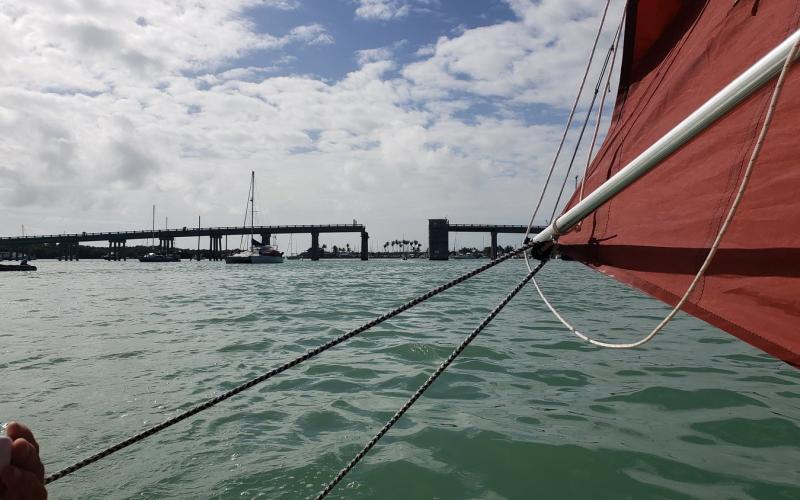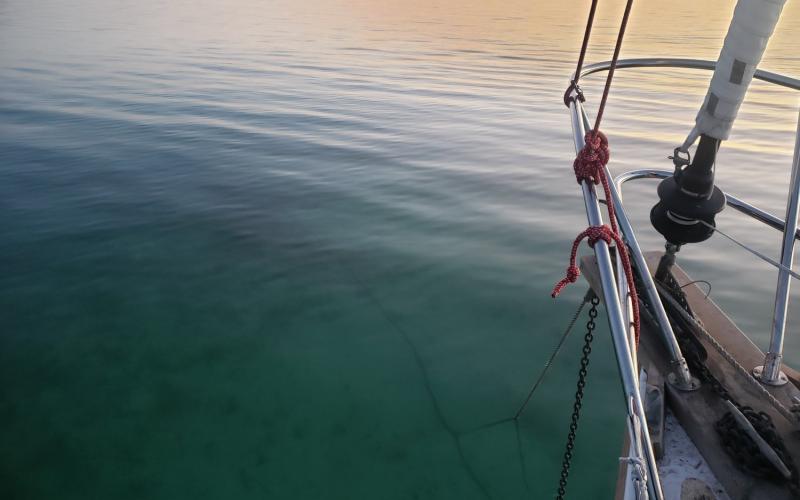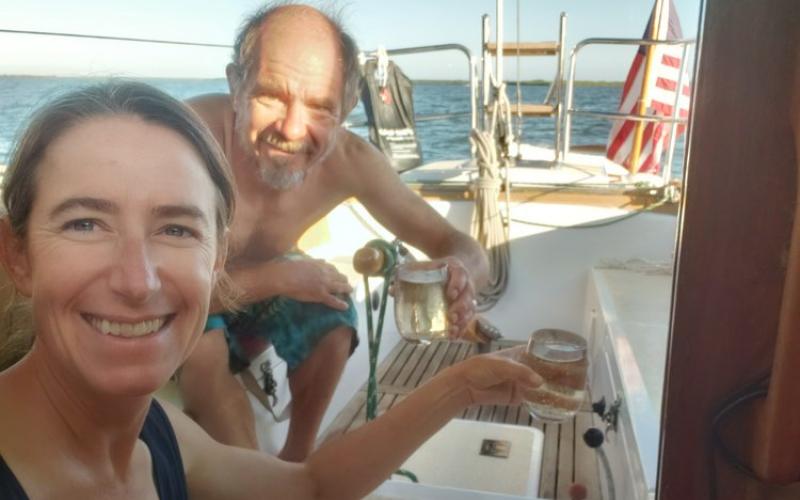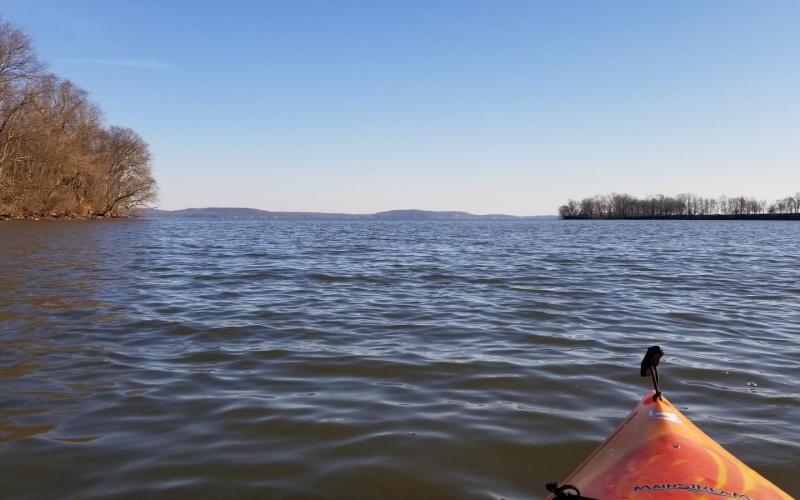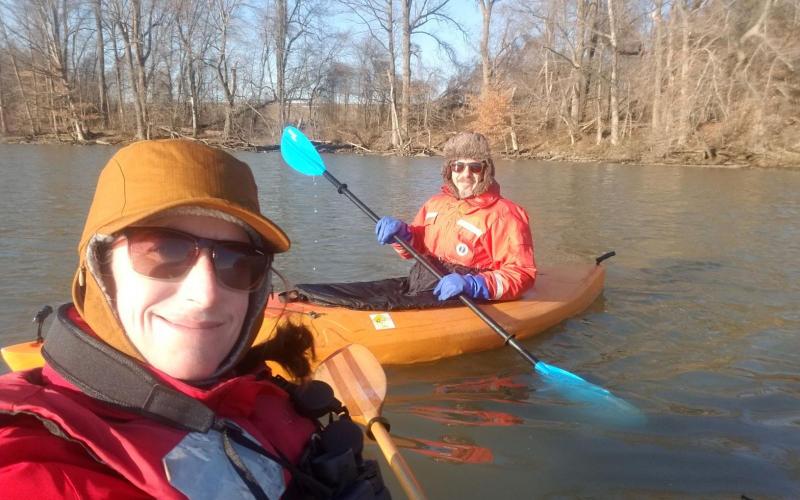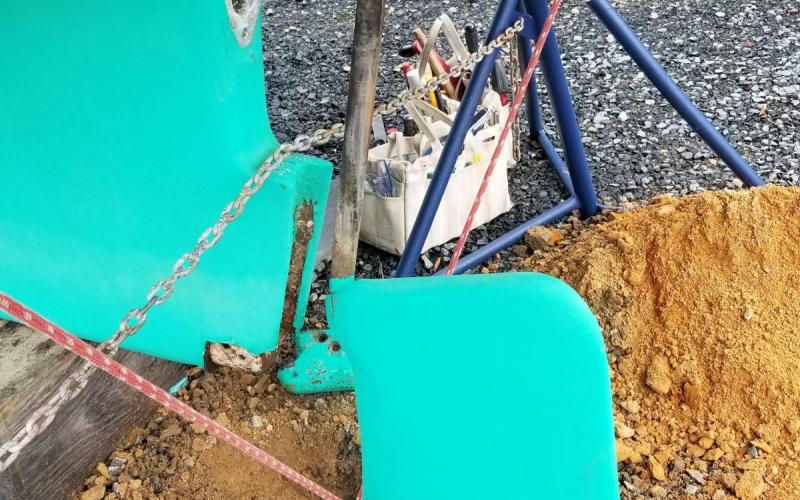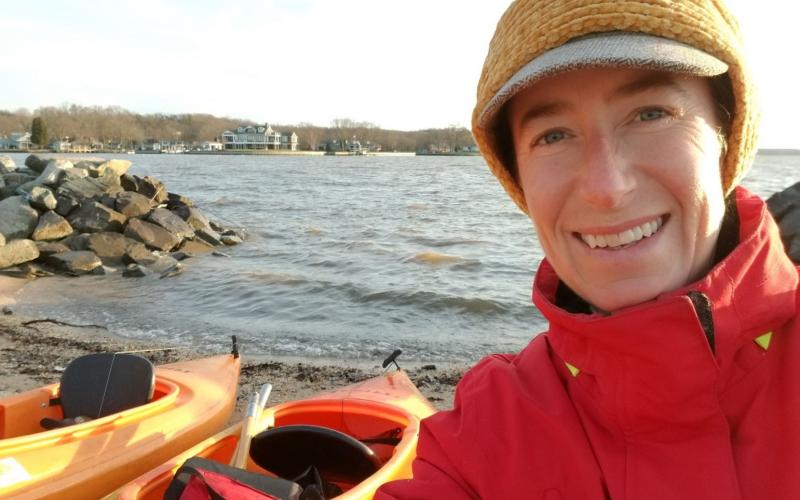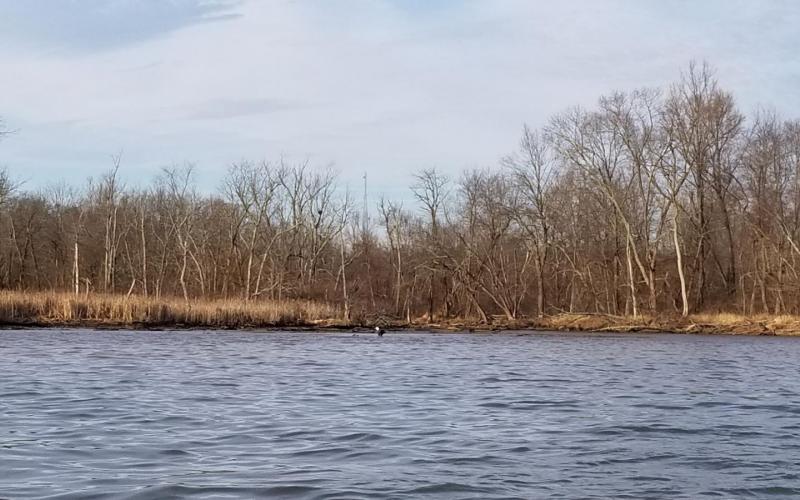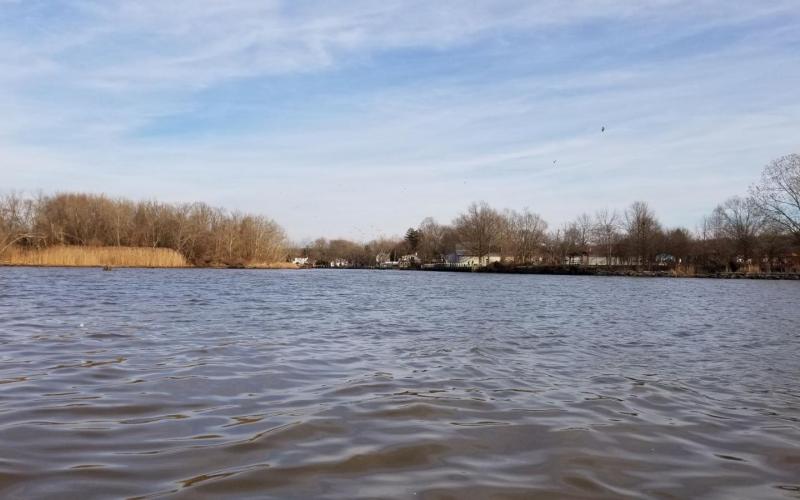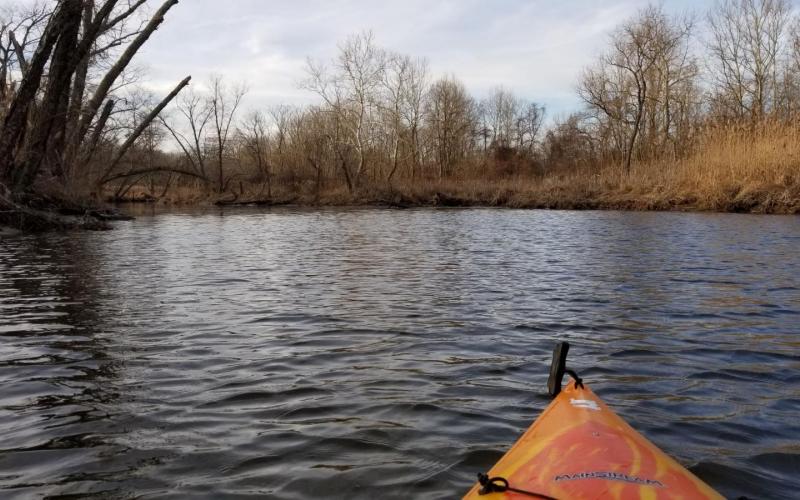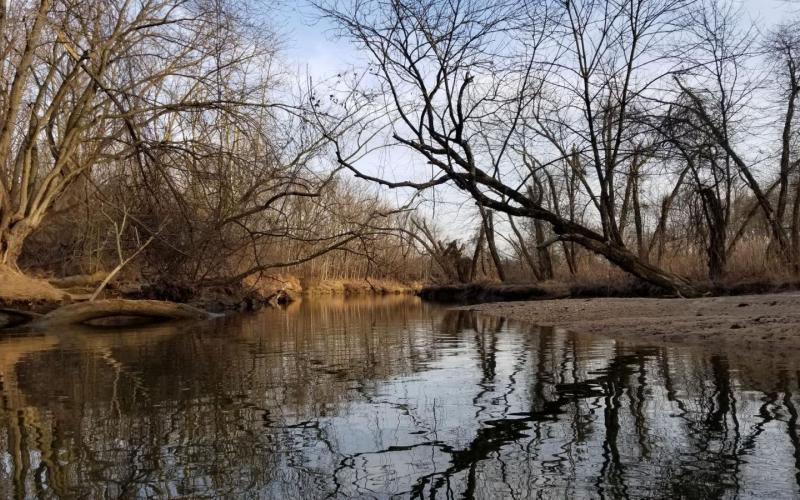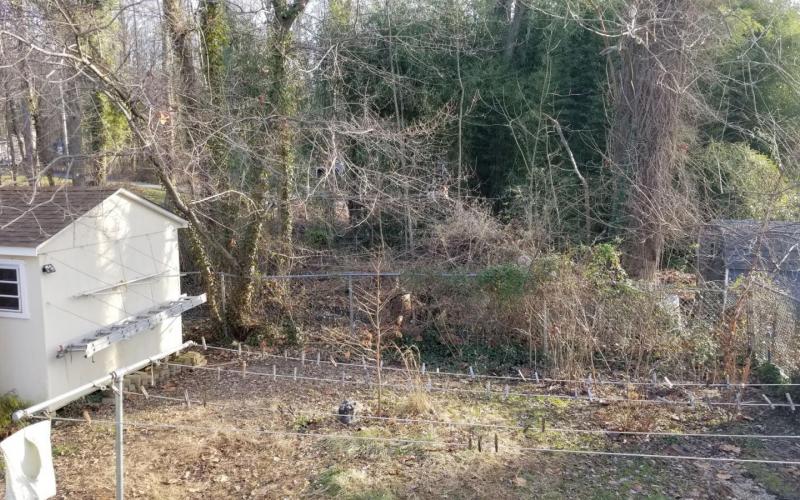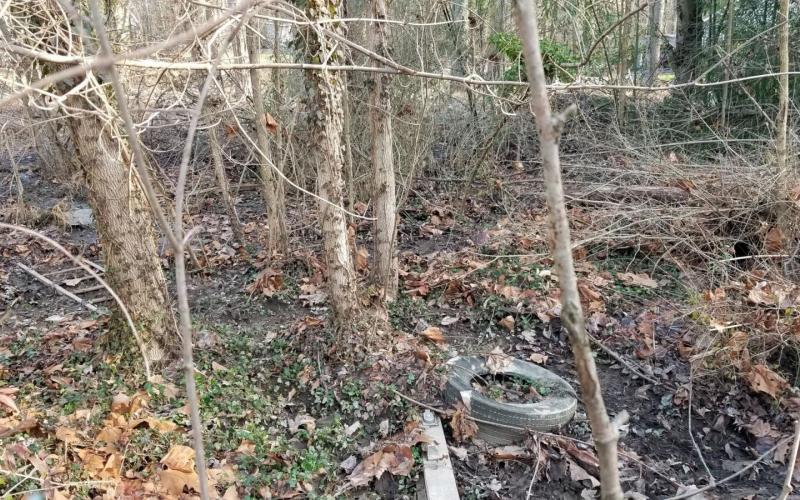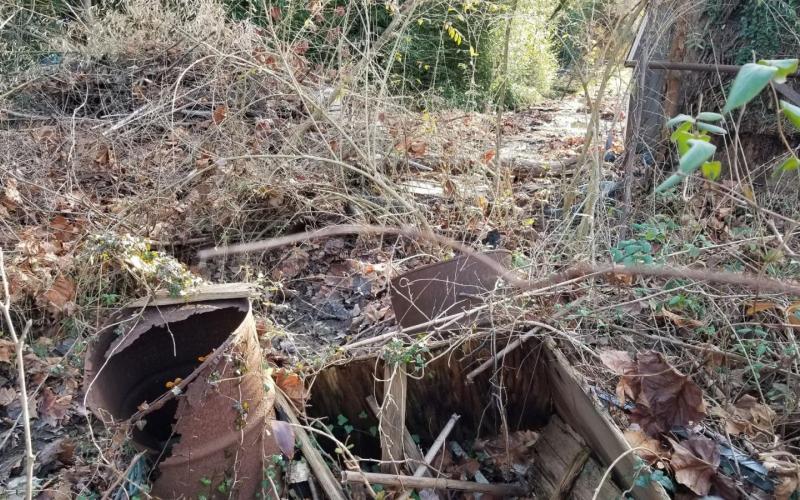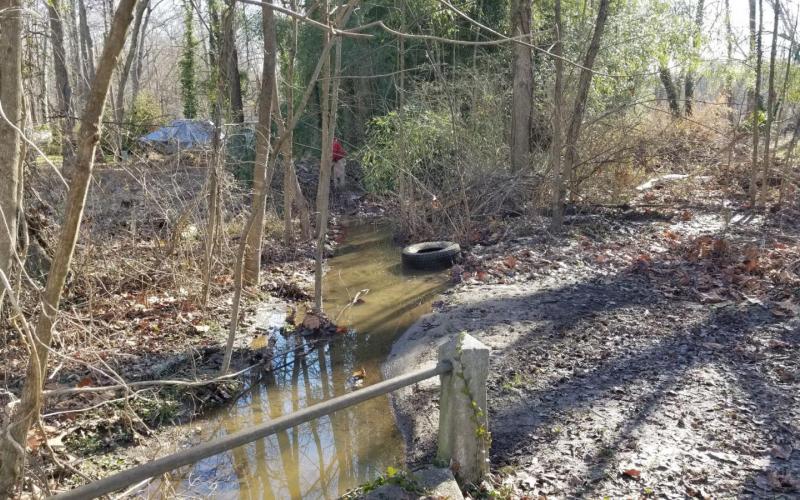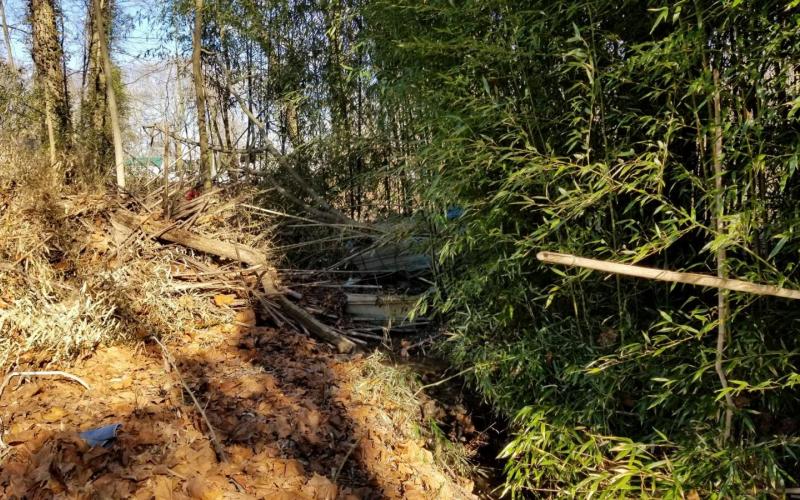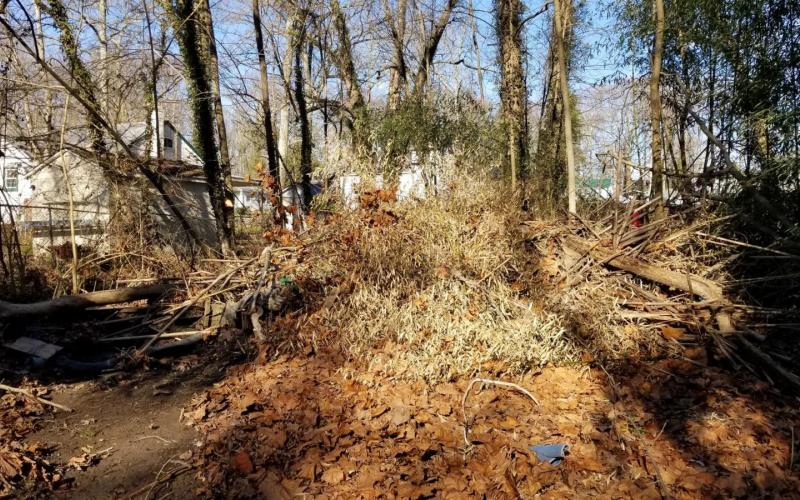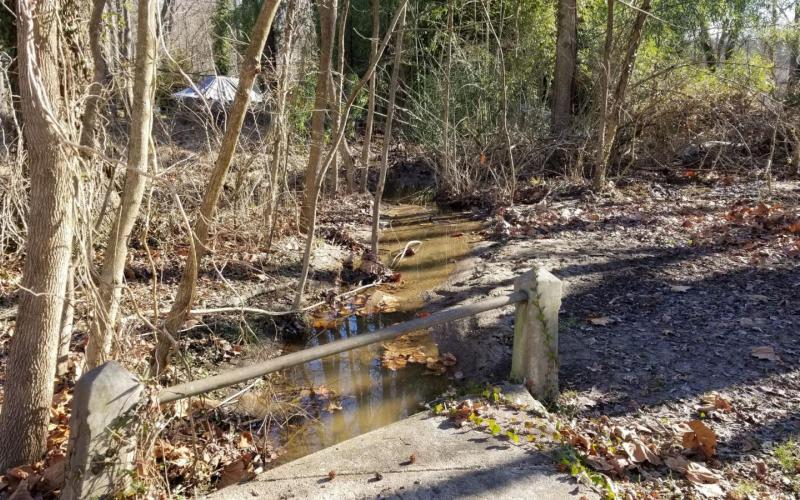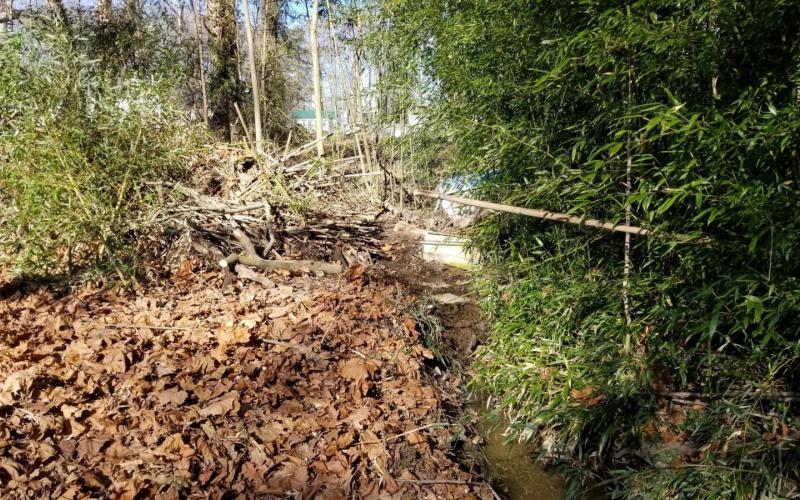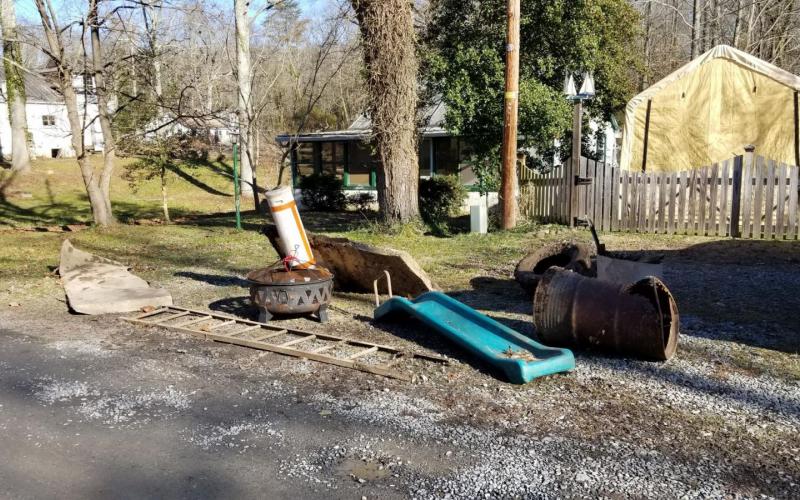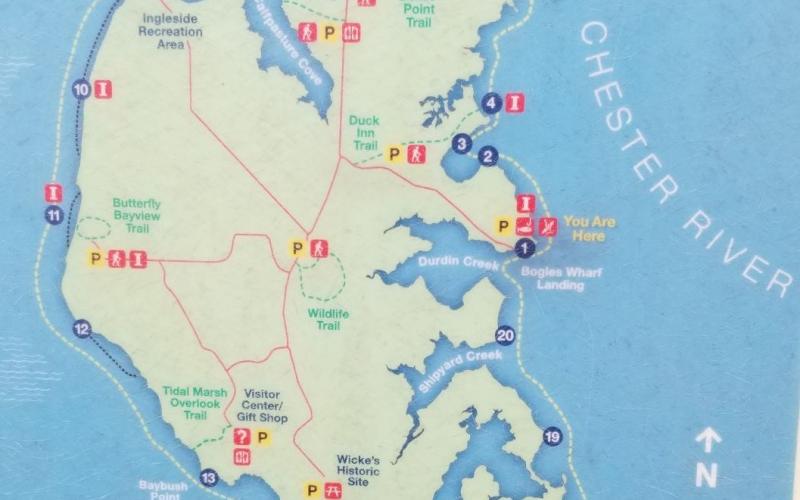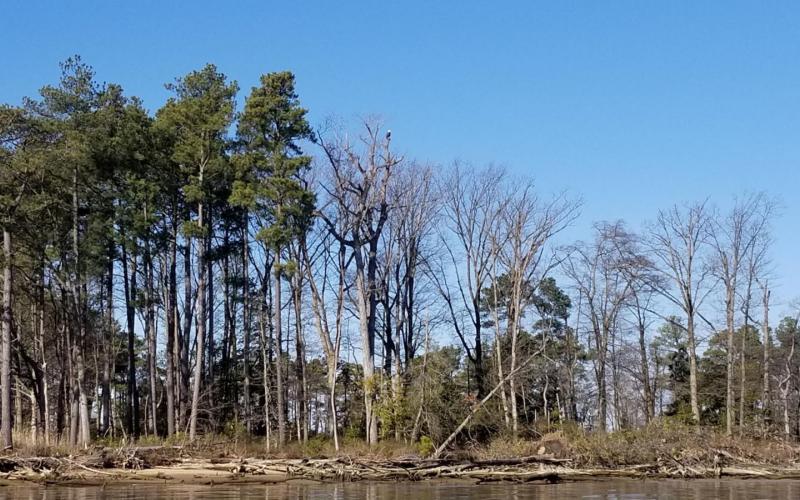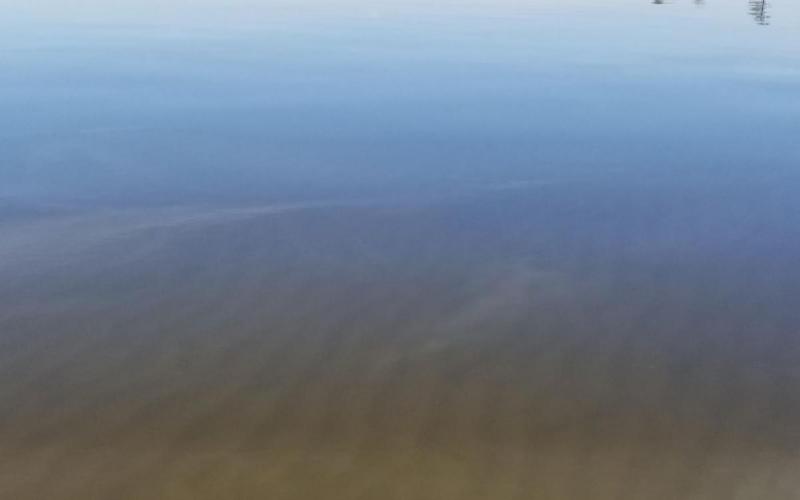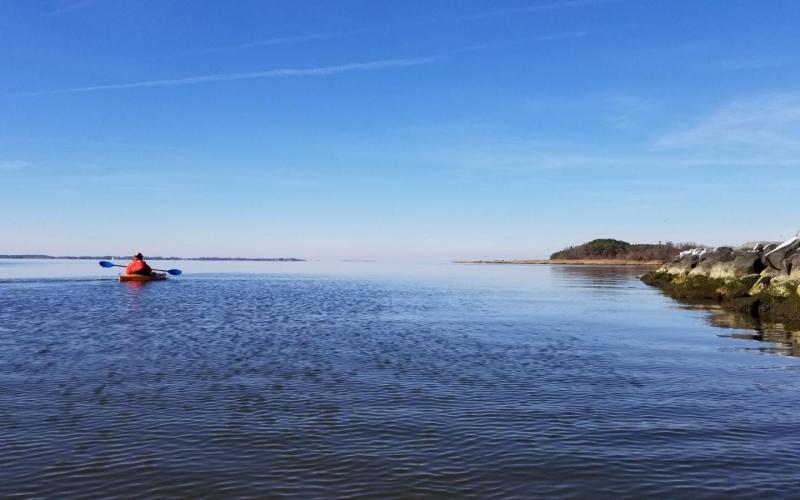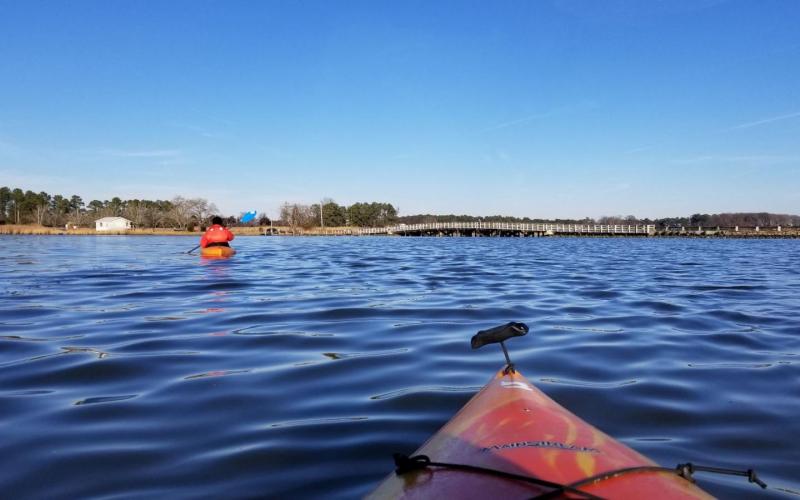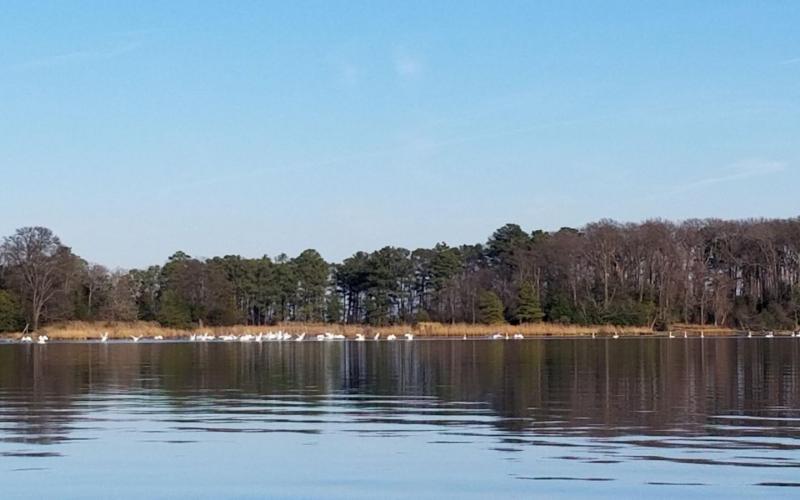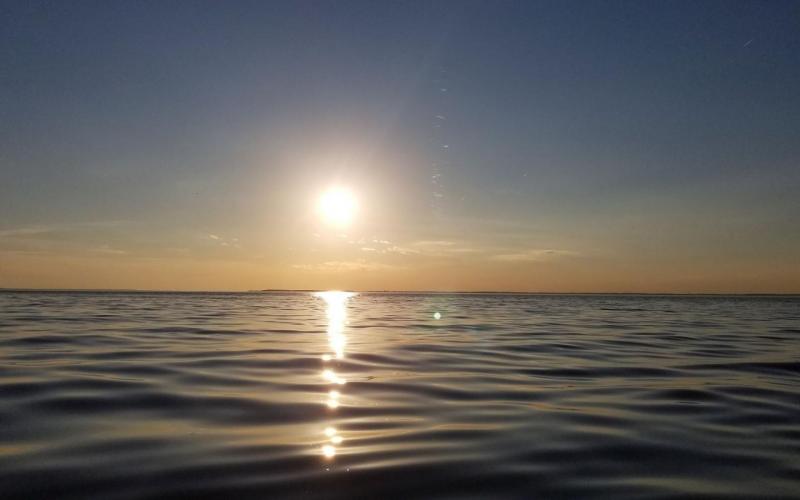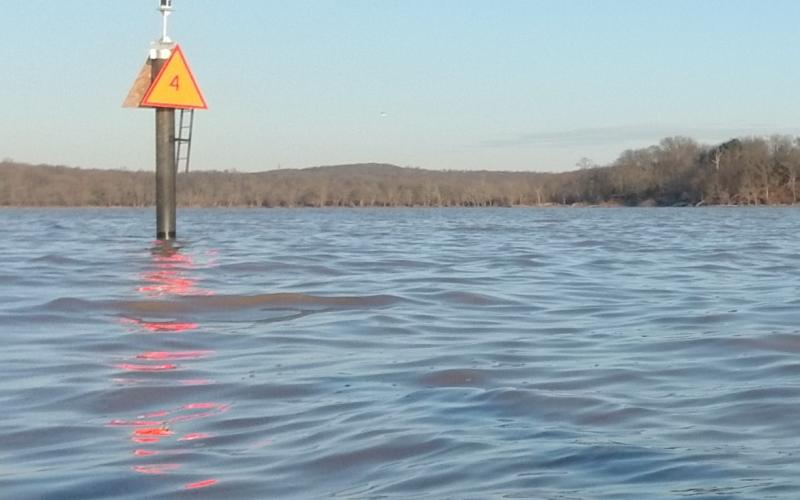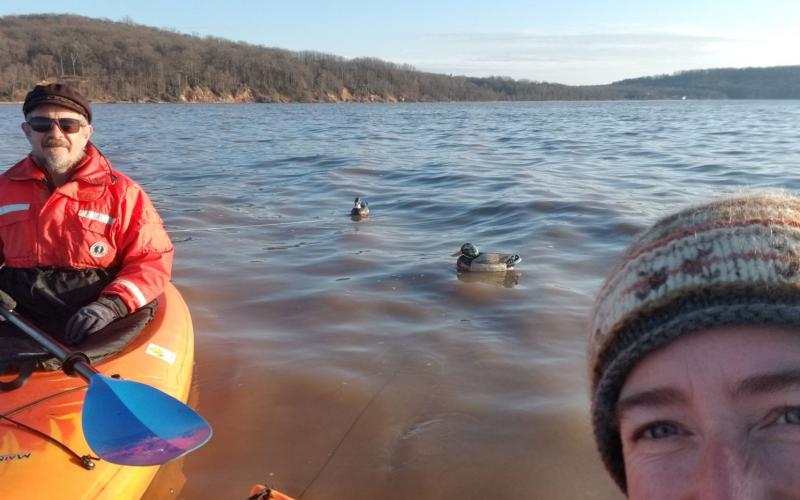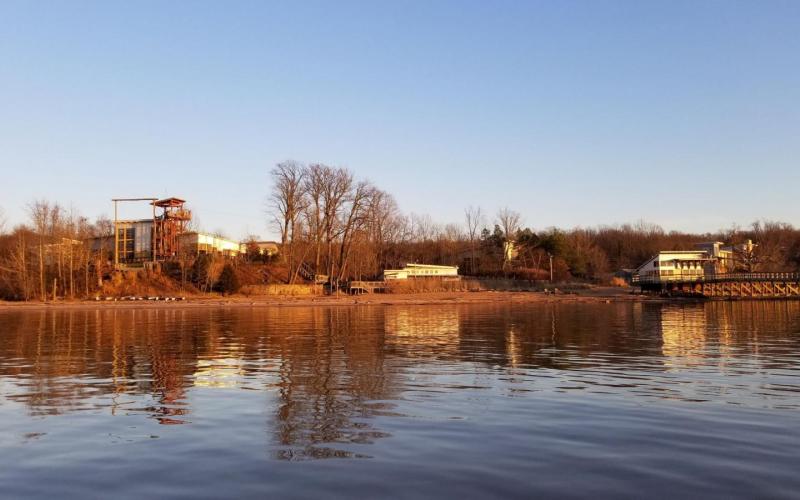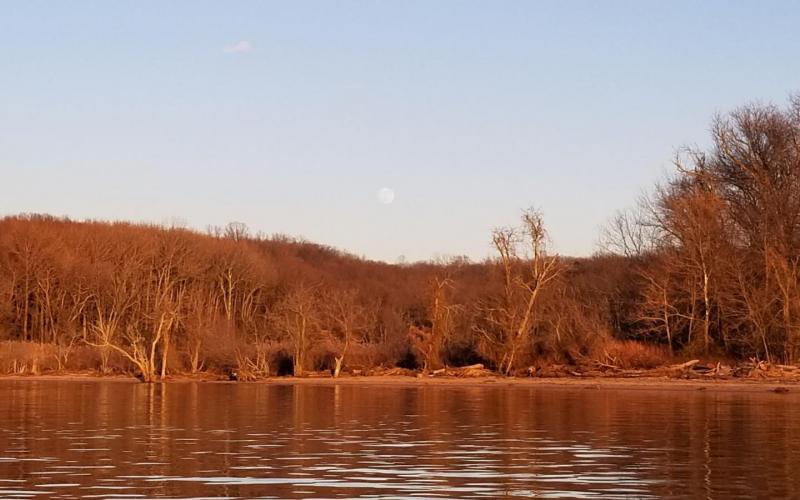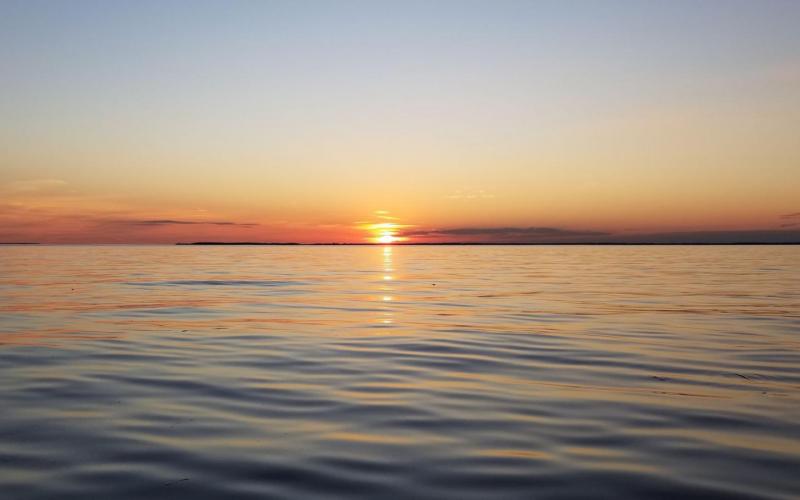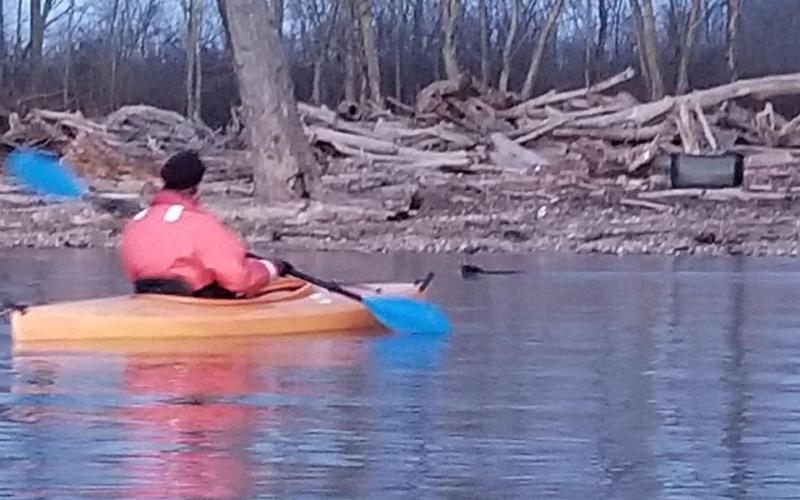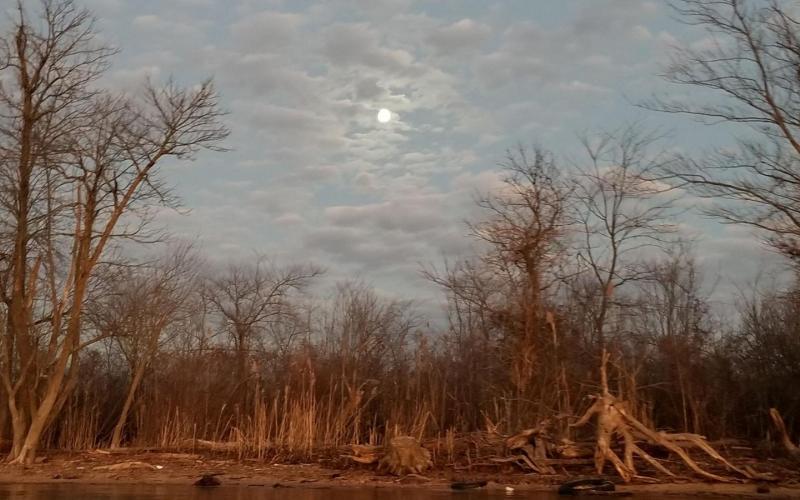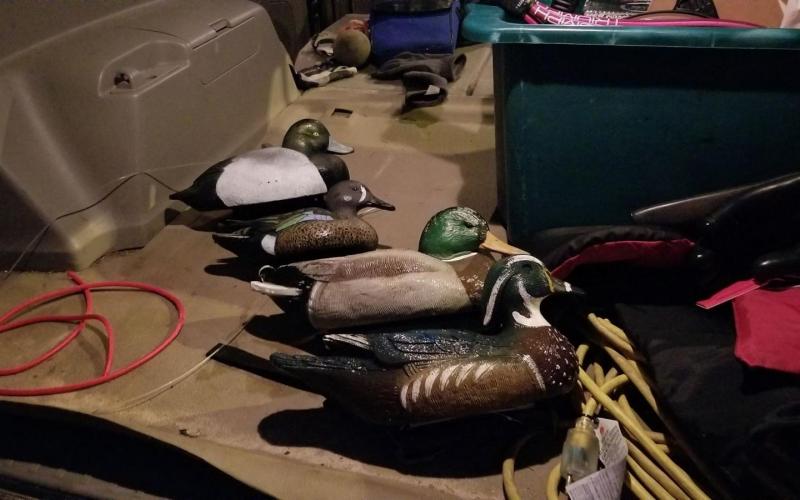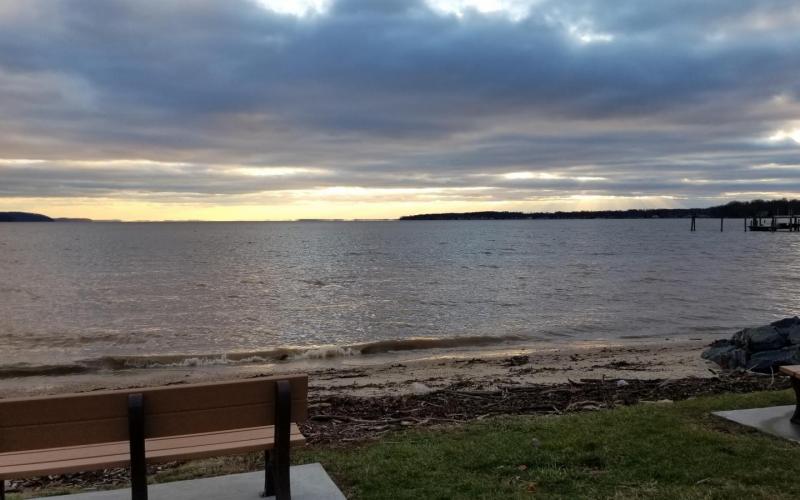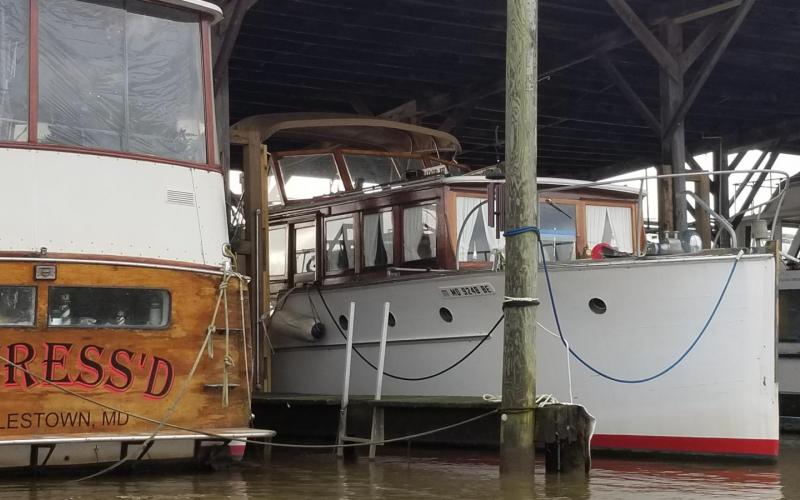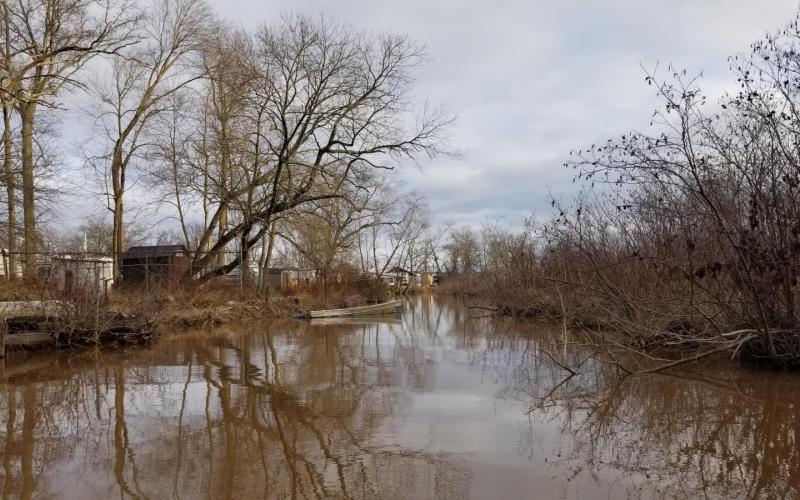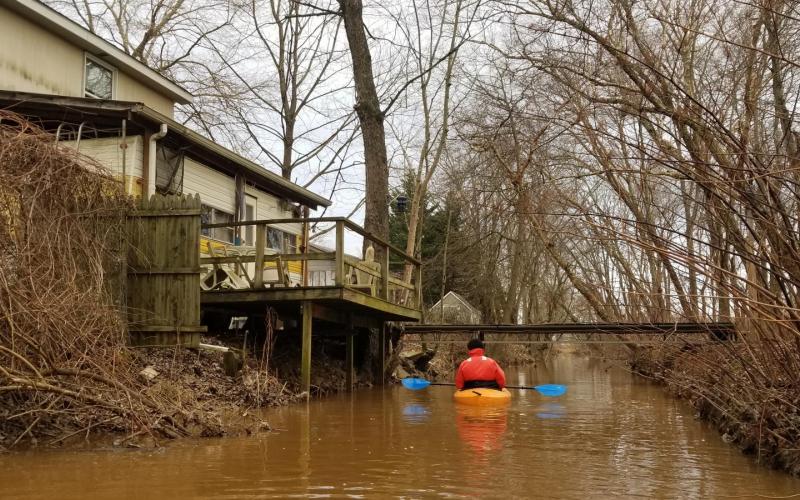Century Club: Suzanne Fryberger
While chilly - a high of 34-degrees coming up from the previous night's low of 19, the day was sunny and the wind light. Dobbs and I couldn't pass up such an opportunity to get out on the water in February.
After wrapping up work early at 2:30pm, we tossed our kayaks on the roof of the truck and drove over to Perryville's Community Park. We put in at the launch and paddled north around the ice-crusted perimeter of Mill Creek. A handful of seagulls stood on a floating ice sheet. Beyond them, to the east, flocks of ruddy ducks paddled out of the creek, wary of our approach. A single common merganser female brought up the ranks. Geese flew in V's overhead. I spied two eagles perched side-by-side high in a tree while great blue herons - something like ten of them - took off from the shore. We continued east to Shipley Point and then southwest across the mouth of the creek to Stump Point. We spotted a couple bufflehead and groups of common mergansers flew by. Out toward the eastern edge of the Flats, we could see the long necks of tundra swans rising above the horizon, and hear their high-pitched hooting. We rounded the corner and paddled just a little bit west along the shore, seeking to inspect more closely a small flock of greater scaup. Then, it was time to return to the boat ramp - the park closes at 5pm, and the sinking sun plus our grumbling stomachs were telling us that was nigh. I took only two photos - just general shots. It's too cold to expose my hands!
...she rested!
Yesterday I achieved my goal (Dobbs did too) - 100 days on the water, on my own boat (since I work on other people's plenty), in 2020. It wasn't easy, but it was worth it. First, COVID-19 kept us away from recreational boating. Our 31' sailboat was on the hard until September as we made major improvements. I had to WORK (sigh), and usually what I do for Walden Rigging is so physically demanding that the idea of one more hour on a boat at the end of the day is unappealing. Then, the weather turned windy and cold. Duck hunters stalked our favorite paddling places.
I logged most of my 100 days between September 15th and the end of the year, 2/3rds of it on "Grace", our 1966 Columbia 31 and the rest in my kayak or occasionally "The Pea Green Boat", our 10' sailing dinghy. Is it worth it, spending so much time on the water? YES! - it's time that challenges me physically, enriches me mentally, and calms me emotionally. I think of it like Mahatma Gandhi saying, " I have so much to accomplish today that I must meditate for two hours instead of one."
My last boating day of the year entailed an hour spent in my kayak, in 41 degree air and a Small Craft Advisory, poking around the head of the Northeast River.
Old habits die hard, and in the case of our neighborhood the habit is dumping trash and debris into the wetland behind our cottage. The 1/10th of an acre of marsh land is privately owned - part of a 9 lot collection, though the owners are seasonal visitors and, instead of cleaning up trash this year, they cut down about 10 big beautiful shade-giving trees instead. We've made offers to buy the land from three different owners over the last twenty years, hoping to protect it, but to no avail. No one wants to separate the single marsh lot from the other eight. Today, we took advantage of one of the "Extra Credit Points for Stay-at-Home Century Club Members" and took clean-up into our own hands - literally.
Dobbs and I donned waterproof boots and work clothes and, over the course of six hours, hauled out several hundred pounds of trash. Almost every item was water-logged and muddy. To get loaded into our truck, each piece had to be carried or rolled up hill from the marsh to the road in front of our house. We extracted: 5 tires, 1 wheel, two 55-gallon steel drums, 1 copper oil tank and piping (good cash-for-scrap find), rotten wood decking from a floating dock, 3/4 of one giant chest freezer (the door is almost entirely submerged and trees have grown over it), a plastic slide, a "No Wake" marker, a steel ladder, 3 footballs, 2 basketballs, 1 baseball, 1 tarp, half a car dolly, an engine block, a steel car fender, a porcelain and bronze marine head, 4 RV window frames, a slew of plastic flower pots, a plastic barrel, and about 1/8th of a fiberglass power boat.
In the course of the clean up, we found that the stream that feeds the wetland had been blocked when neighbors cut down bamboo and then bulldozed it, along with trash and the boat, into the stream bed. We'd noticed that area becoming wetter than usual - like the beginnings of a mill pond - over the last year. What do you know? It was! The ponding area was a couple feet higher than the outflow stream. We cut and raked out the dead bamboo and piled it off to one side. Then Dobbs used a ryoba to cut a swath out of the wrecked boat, to allow the stream to flow through. I raked dead leaves from the stream bed up onto the banks and graded the bed to a more gradual descent. By the time we were exhausted, the flow was much improved.
We carted the trash - two truck-loads worth - off to the landfill. The wetland could still benefit from more management - hauling away of the organic debris (primarily the bamboo) and the remaining trash, and additional restoration - but that will have to wait for another day. We feel good about what we achieved and we hope our neighbors will notice, and begin to take better care of this special spot.
41 degrees, abundant sunshine, wind S at 0-5 knots
From time to time as we've sailed into the Chester River, Dobbs has pointed toward Eastern Neck National Wildlife Refuge and mentioned wanting to explore it. Today we finally had the time, the ambition to make the drive (which, for us, is about 2 hours each way), and the perfect weather. I popped James Galway's rendition of Mozart into the CD player and away we went, driving down the Eastern Shore with the road mostly to ourselves.
Eastern Neck is an island, so there's a definite moment (besides the Welcome sign) when you know you've arrived: All of the houses and marinas of Rock Hall are in the rear view and before you is a small wooden bridge surrounded in marsh. Beyond the marsh to the west lies the Chesapeake Bay; to the east, the Chester River. Crossing the bridge is like entering a portal to the Chesapeake of 200 years ago - low-lying land ringed in marsh grass and elevated stands of pine forest teeming with wildlife and dotted only sparsley with buildings and roads. The quiet - that is, the absence of man-made noise - is delightful, the air resonating with the calling of ducks, the high-pitched coo of tundra swans, and the honking of geese.
We drove down to Bogle's Wharf to launch our kayaks and begin our journey on the Eastern Neck Island Water Trail. From the sign posted there: "Welcome to the Eastern Neck Island Water Trail. Located at the mouth of the Chester River, the 2,285-acre Eastern Neck Wildlife Refuge is a magnet for bird watchers as it is an important feeding and resting area for migratory and wintering waterfowl. Stretching 10 miles (oops - I assured Dobbs it was only 8...) the Eastern Neck Island Water Trail circles the island and offers experienced paddlers a rich and challenging experience. This route may appear simple, but it includes long stretches of open tidal water. Along the way, you will see abundant wildlife and stunning scenery."
From Bogles Wharf, we departed Durdin Creek and paddled clockwise around the island, passing Shipyard Creek and several small coves before pausing for a floating lunch at Hail Creek. In the clear, shallow water, riffles in the sand stretched out beneath us in all directions. After lunch, we continued west around Cedar Point and Panhandle Point, noting the flood tide pushing against us. The wind was calm and the Bay was still as glass. On and on we went, now more north than west, past Baybush Point and Wickes Point, and finally into the cut that divides the island from the mainland. Every point that we approached offered an opportunity to sneak up on ducks before they'd spot us and scoot or fly away; by "sneak up" I mean about 1/4 mile - any closer and off they go. The challenges we've found with winter waterfowl-watching are that the birds are quite skittish and the low sun angle makes it hard to identify colors. This doesn't stop us from trying! I can't blame the birds for being wary - at this point in the year, they've been shot at for going on 4 months. While Eastern Neck Island may be a refuge, the neighboring shores are not. We saw buffleheads, Canada geese, a pair of loons, ruddy ducks, mallards, goldeneyes, and Tundra Swans; also one lone oldsquaw. We may have also seen pintails, but we couldn't be sure. It was a beautiful day. Eastern Neck Island NWR is well worth a visit.
Temperature in the low 40's, sunny, wind SW at 5-10
After yesterday's 10-mile paddle around Eastern Neck Island, Dobbs and I felt sore and not at all eager to get right back to it this morning. Instead, we puttered indoors for most of the day, waiting until 3pm to head down to the beach with our kayaks. The air felt warm and the sun was bright. We launched into the Northeast River and paddled toward Red #4 against a mild flood tide, the sun full on us and delightful. At Red #4, we pointed our bows southeast toward North Bay Adventure Camp and arrived inside their breakwaters about twenty minutes before sunset. North Bay is striking in architectural appearance, but even more impressive in its mission to "Challenge people through transformative educational and retreat experiences to realize their attitudes and actions have a lasting impact on their lives, communities, and the environment." As we paddled through, we startled some Canada geese and mallards and they went flying and honking off downriver. As we turned our bows back north, a full moon hung in the trees over Elk Neck. Beautiful!
We kayaked back along the shoreline, surveying the terrain and beach-combing (by boat). We came upon an abandoned decoy - a scaup - and added it to our collection. Later, Dobbs found another decoy - this time a blue-winged teal - washed up in a heap of logs, and adopted it as well. We saw a woodpecker, a red cockaded or downy one - we'd left our binoculars in the truck, regrettably. As well, we happened upon small flocks of various ducks, but again, without binoculars, we couldn't accurately determine what we were seeing except for some goldeneye. Astern, the sun set in a quiet blaze of pink and orange; ahead, the moon grew brighter in a darkening sky. We landed on the beach at Red Point around quarter after 5pm and headed home for dinner.
Merry Christmas! Mid 30's, mostly cloudy, flurries, wind SW 10-20 with gusts to 25
When I write "mostly cloudy", I envision a dull gray sky unlike today's that, while blanketed in clouds, was active in color as sunlight radiated through. Mid-afternoon, Dobbs and I launched our kayaks at the Charlestown Long Park. We were seeking protection from the strong southwest breeze, so we followed the shoreline north, poking into the fairways of Charlestown Marina and The Wellwood.
We paddled back into the abandoned basin by Avalon Park and then farther back, exploring the small creek that runs alongside Edgewater Avenue.
